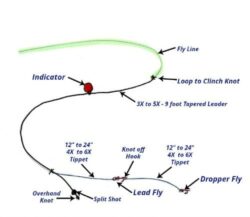Strike indicators, or “Bobbers”, are often used by fly fishermen. Most guide boats have their clients hooked up with his rig. Two nymphs are on the end and the bobber, yarn, Palsa pad, or other floater is supposed to identify strikes. When the Bobber wiggles, “Cross their eyes!”
This type of nymph fishing is great to learn how to nymph fish. Over 80% of a trout’s diet is subsurface nymphs, or drowned bugs. Most Fly Fishermen are poor Nymphers. If you take away a Bobber, they are lost.
Truth be told, the Best Nymphers rarely use a Bobber. They have mastered the art of closely monitoring their leader, line, and casts. They often just use one well-presented nymph. There are times when a small Bobber helps create certain presentations. These uses are often on windy or rough water days. You can also use fly flotant on your line and tippet to make an indicator that is a couple feet long.
Nymph fishermen never see most of their strikes. Fish grab and spit their hairy, furry offerings in a hurry. Many nymphs are made of wore, lead, beads, and non-natural materials. As soon as the trout smells a booger. They spit the fly. Many strikes are lighter than light. Most hook sets are purely instinctive reactions. If you have to think about the hook set, you already missed them.
Mending is a huge part pf proper nymphing. The fly needs to floating at the same speed as the current. You also need to be on or near the bottom. This means that the nymph must be weighted, or split shot is applied. Use the lightest tippet that you are comfortable with.
There is no law that says the weight needs to be above the fly. Try adding the weight at the end of the tippet. Use a dropper, off a Blood Knot, to present the nymph at the depth you desire. If the split shot gets snagged, it will slide off and you will not lose the fly. You can also do this in reverse. Tie the nymph to the end of the tippet and drop the weight off the Blood knot dropper, maybe a foot or so above.
Set the hook when you think you have a bite! The worst that will happen is that you make another cast. Always set the hook by raising the rod up, not sideways. To add 2 feet to the rod, set the hook from your shoulder, while keeping your arm straight.
Finally, sharpen your hooks often. Your hooks are often in the rocks. It does not take much to bend the hooks tip or take off the point.
Nymph Naked!
Montana Grant